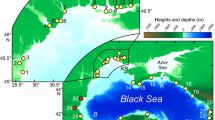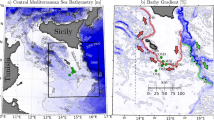Abstract
The loading tides are calculated by means of the Green’s function method based on a high-resolution regional ocean tide model, the TOPO7.0 global ocean tide model, and the Gutenberg-Bullen A Earth model. The results show that the maximal amplitude of M2 vertical displacement loading (VDL) tide in the Bohai, Yellow, and East China Seas exceeding 28 mm appears 150 km off the Zhejiang coast; the second maximum exceeding 20 mm appears in Inchon Bay; and the third maximum exceeding 14 mm is located in the northeast of the North Yellow Sea. The maximal amplitudes of S2 VDL tide at the above three locations exceed 10, 8, and 4 mm, respectively. The maximal amplitudes of the K1 and O1 VDL tides, exceeding 13 and 10 mm respectively, appear near the central and north Ryukyu Islands; the amplitudes tend to decease toward the inward areas. The phases of semidiurnal VDL tides are basically opposite to those of corresponding ocean tides. The phases of diurnal VDL tides are basically opposite to those of corresponding ocean tides in the most part of the East China Sea and the eastern part of the South Yellow Sea. This anti-phase relationship generally does not hold in the rest parts of the Bohai and Yellow Seas. The distribution patterns of self-attraction and loading (SAL) tides are very similar to those of VDL tides. The SAL tides have amplitudes about 1.2–1.7 times of the corresponding VDL tides and their phases are basically opposite to the corresponding VDL tides. The maximal amplitude of M2 SAL tide also appears off the Zhejiang coast, with a magnitude exceeding 42 mm.
Similar content being viewed by others
References
Wang Y, Fang G, Wei Z, et al. Accuracy assessment of global ocean tide models based on satellite altimetry (in Chinese). Adv Earth Sci, 2010, 25: 353–359
Zhou X, Wu B, Zhu Y, et al. The ocean tide displacement corrections for Earth crust movement network of China. Chin Astron Astrophys, 2002, 26: 82–87
Xu H, Mao W. The correction model of ocean load tides in Chinese continent. Sci China Ser B, 1989, 32: 618–630
Zheng Y, Wu J, Wang J, et al. Effect of ocean tide model and Green’s function on ocean tidal displacement correction (in Chinese). J Geod Geodyn, 2002, 22: 71–76
Zhou J, Xu H, Sun H. Influence of ocean load tides on gravity, displacement, tilt and strain in Taiwan (in Chinese). J Geod Geodyn, 2002, 22: 81–86
Yuan LG, Ding XL, Sun HP, et al. Determination of ocean tide loading displacements in Hong Kong using GPS technique. Sci China Ser D-Earth Sci, 2010, 53: 993–1007
Chen Z Y. Tidology (in Chinese). Beijing: Science Press, 1980. 1–301
Fang G, Zheng W, Chen Z, et al. Analysis and Prediction of Tides and Tidal Currents (in Chinese). Beijing: Ocean Press, 1986. 1–474
Huang Z K, Huang L. Tidal Theory and Calculation (in Chinese). Qingdao: China Ocean University Press, 1995. 1–293
Wahr J M. Body tides on an elliptical, rotating, elastic and oceanless earth. Geophys J R Astron Soc, 1981, 64: 677–703
Farrell W E. Deformation of the Earth by surface loads. Rev Geophys Space Phys, 1972, 10: 761–797
Francis O, Mazzega P. Global charts of ocean tide loading effects. J Geophys Res, 1990, 95: 11411–11424
Agnew D C. NLOADF: A program for computing ocean-tide loading. J Geophys Res, 1997, 102: 5109–5110
Agnew D C. SPOTL: Some programs for ocean-tide loading. User’s Manual Version 3.2.1. Scripps Institution of Oceanography, University of California, 2005
Ray R D. Ocean shelf-attraction and loading in numerical tidal models. Mar Geod, 1998, 21: 181–192
Fang G, Wang Y, Wei Z, et al. Empirical cotidal charts of the Bohai, Yellow and East China Seas from 10 years of TOPEX/Poseidon altimetry. J Geophys Res, 2004, 109: C11006
Egbert G D, Erofeeva S Y. Efficient inverse modeling of barotropic ocean tides. J Atmos Oceanic Tech, 2002, 19: 183–204
Fang G, Kwok Y, Yu K, et al. Numerical simulation of principal tidal constituents in the South China Sea, Gulf of Tonkin and Gulf of Thailand. Cont Shelf Res, 1999, 19: 845–869
Author information
Authors and Affiliations
Corresponding author
Rights and permissions
About this article
Cite this article
Fang, G., Xu, X., Wei, Z. et al. Vertical displacement loading tides and self-attraction and loading tides in the Bohai, Yellow, and East China Seas. Sci. China Earth Sci. 56, 63–70 (2013). https://doi.org/10.1007/s11430-012-4518-9
Received:
Accepted:
Published:
Issue Date:
DOI: https://doi.org/10.1007/s11430-012-4518-9




